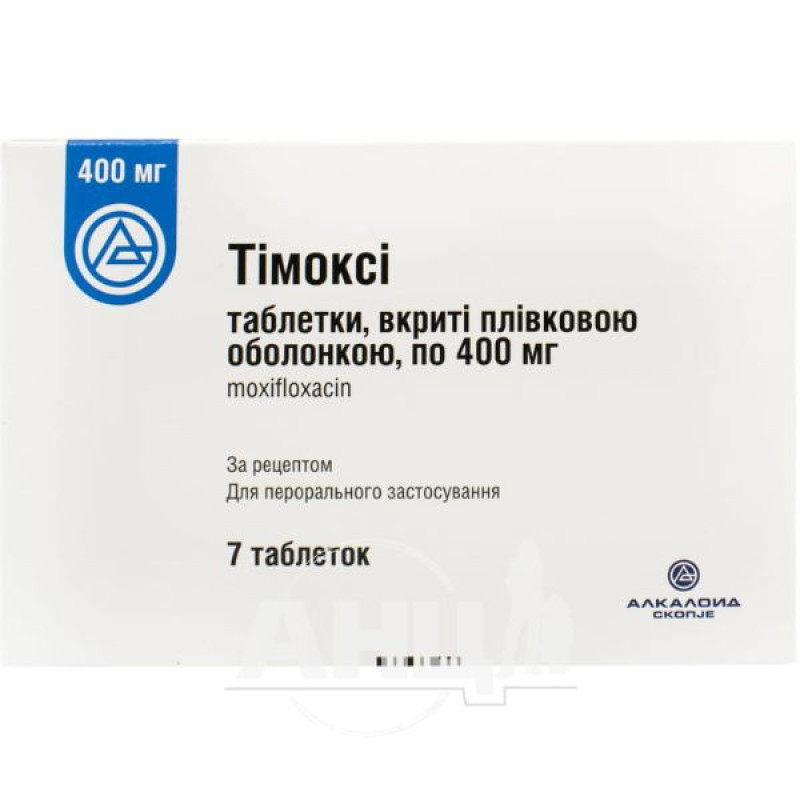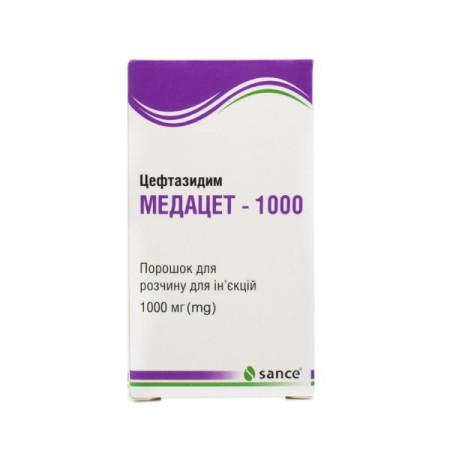Timoxi film-coated tablets 400 mg blister No. 7

Timoxi tablets are used to treat the following bacterial infections caused by susceptible microorganisms in patients aged 18 years and over. Moxifloxacin should only be prescribed when antibacterial agents usually recommended for the initial treatment of the following infections are inappropriate or when such treatment has been ineffective.
Acute bacterial sinusitis (diagnosed with a high degree of certainty). Exacerbation of chronic obstructive pulmonary disease, including bronchitis (diagnosed with a high degree of certainty). Community-acquired pneumonia, except for severe pneumonia. Mild to moderate pelvic inflammatory disease (including upper genital tract infections in women, including salpingitis, and endometritis), not associated with tubo-ovarian abscess or pelvic abscess.The drug "Timoxi" is not recommended for use as monotherapy for mild to moderate pelvic inflammatory disease, but can be used in combination with other appropriate antibacterial agents (e.g. cephalosporins) due to the increasing resistance of moxifloxacin to Neisseria gonorrhoeae (with the exception of moxifloxacin-resistant strains of N. gonorrhoeae).
The drug "Timoxi" can be used to complete a course of treatment in which the initial therapy with the parenteral form of moxifloxacin was effective and prescribed for the following indications:
community-acquired pneumonia; complicated infections of the skin and subcutaneous structures.The drug "Timoxi" is not recommended for use as initial therapy for any type of infection of the skin and subcutaneous structures or severe pneumonia.
Official recommendations on the appropriate use of antibacterial drugs should be considered.
Composition
The active substance is moxifloxacin (one film-coated tablet contains 400 mg of moxifloxacin (as moxifloxacin hydrochloride)).
Excipients: tablet core: microcrystalline cellulose, partially pregelatinized corn starch, low-substituted hydroxypropylcellulose, sodium lauryl sulfate, sodium stearyl fumarate; shell: opadry II orange (polyvinyl alcohol, titanium dioxide (E 171); polyethylene glycol, talc, sunset yellow dye (E 110)).
Contraindication
Known hypersensitivity to moxifloxacin or to other quinolones or to any of the excipients of the drug.
Children under 18 years of age.
Pregnancy or breastfeeding.
Patients with a history of tendon disorders associated with quinolone treatment.
During preclinical studies and clinical trials, changes in cardiac electrophysiology in the form of prolongation of the QT interval were observed after the use of moxifloxacin. Therefore, for safety reasons, the drug is contraindicated in patients with:
Congenital or established acquired prolongation of the QT interval; electrolyte imbalance, especially in uncorrected hypokalemia; clinically significant bradycardia; clinically significant heart failure with reduced left ventricular ejection fraction; history of symptomatic arrhythmias.The drug should not be used in combination with other drugs that prolong the QT interval.
Due to insufficient clinical data, the use of the drug is also contraindicated in patients with impaired liver function (class C according to the Child-Pugh classification) and patients with increased transaminase levels (5 times the upper limit of normal).
Method of application
Dosage (adults): It is recommended to take one tablet (400 mg) of moxifloxacin per day.
The tablets should be taken without chewing, with sufficient water. The drug can be taken regardless of meals.
The duration of therapy with the drug "Timoxi" depends on the type of infections and is:
exacerbation of chronic obstructive pulmonary disease, including bronchitis - 5-10 days; community-acquired pneumonia - 10 days; acute bacterial sinusitis - 7 days; mild and moderate pelvic inflammatory disease - 14 days.According to clinical studies, the duration of treatment with moxifloxacin (tablets) was up to 14 days.
Sequential therapy (intravenous administration followed by oral administration). In clinical trials with sequential therapy, most patients were switched from intravenous to oral therapy within 4 days (communicable disease pneumonia) or 6 days (complicated skin and soft tissue infections). The recommended total duration of treatment with moxifloxacin tablets and solution for infusion is 7-14 days for pneumonia and 7-21 days for complicated skin and soft tissue infections.
Exceeding the specified dose (400 mg once a day) and duration of treatment for each indication is not recommended.
Application features
No studies on the effects of moxifloxacin on the ability to drive or use machines have been conducted. However, fluoroquinolones, including moxifloxacin, may impair the ability to drive or use machines due to central nervous system reactions (e.g. dizziness; acute transient visual loss) or sudden and transient loss of consciousness (visual loss). Patients should be advised to observe their reaction to moxifloxacin before driving or operating machinery.
Overdose
In case of accidental overdose, no specific measures are recommended. In case of overdose, the clinical picture should be guided and symptomatic supportive therapy and ECG monitoring should be carried out due to the possibility of QT prolongation.
Co-administration of activated charcoal with 400 mg oral moxifloxacin will result in a reduction in systemic exposure of more than 80%. In the event of an oral overdose, administration of activated charcoal at the initial stage of absorption may be effective in preventing increased systemic exposure to moxifloxacin.
Side effects
The following are adverse reactions reported in clinical trials and post-marketing reports with moxifloxacin (oral and step therapy).
These adverse reactions were observed at a frequency of less than 3%, with the exception of nausea and diarrhea. The frequency is defined as follows: common (≥ 1/100, < 1/10).
Infectious complications: superinfection due to resistant bacteria or fungi, such as oral and vaginal candidiasis.
From the nervous system: headache, dizziness.
Cardiac: QT prolongation in patients with hypokalemia.
Gastrointestinal: nausea, vomiting, gastrointestinal and abdominal pain, diarrhea.
Hepatobiliary disorders: increased transaminase levels.
Storage conditions
This medicine does not require any special temperature storage conditions. Store in the original packaging to protect from light and out of the reach of children.
Shelf life - 3 years.
There are no reviews for this product.
There are no reviews for this product, be the first to leave your review.
No questions about this product, be the first and ask your question.






